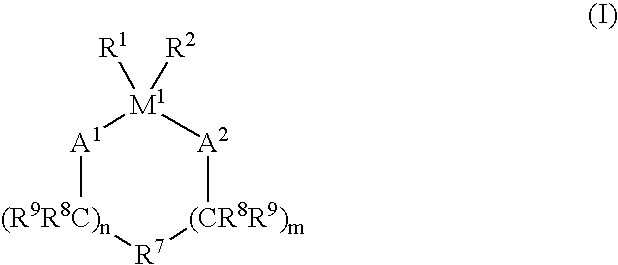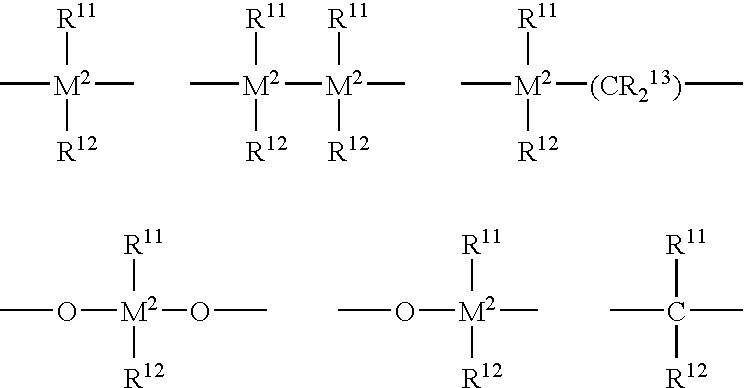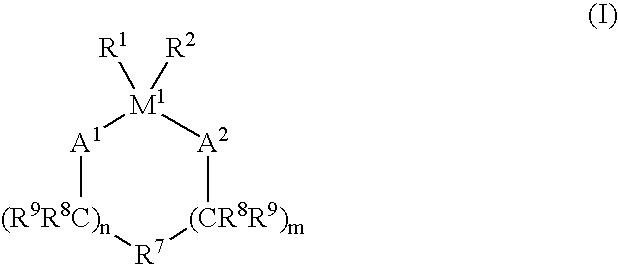Process for the oligomerization of α-olefins having low unsaturation
a technology of unsaturated oligomerization and -olefin, which is applied in the direction of physical/chemical process catalysts, organic-compound/hydride/coordination complex catalysts, physical/chemical process catalysts, etc., can solve the problem of difficulty in directly producing lubes of the lower viscosity range without incurring lower yields
- Summary
- Abstract
- Description
- Claims
- Application Information
AI Technical Summary
Benefits of technology
Problems solved by technology
Method used
Image
Examples
example 1
[0131]A dried 3-liter Büchi reactor was filled under argon with 1,250 mL of dry 1-decene. The reactor temperature was brought up to 90° C. with agitation and then sufficient hydrogen was added to bring the reactor pressure to 200 psig. A solution of 0.012 gram of meso-dimethylsilyl bis(2-methyl-1-indenyl)zirconium dichloride, i.e., meso-Me2Si(2-MeInd)2ZrCl2, dissolved in 15 mL of toluene and 4.4 mL of a 10 wt % solution of MAO in toluene that had been prepared 30 minutes prior to use was injected into the stirred reactor with a slight overpressure of argon. The reactor was maintained at a pressure of 200 psig via addition of hydrogen on demand and a temperature of 90° C. was maintained for a period of 30 minutes. Upon completion and work-up of the reaction, 740.4 grams of a clear, colorless liquid polyolefin material was obtained for a catalyst efficiency of 61.70 Kg / g. Kinematic viscosity measurements at 100° C. and 40° C. showed values of 39.4 and 312 cSt, respectively. The viscos...
example 2
[0132]A dried 3-liter Büchi reactor was filled under argon with 1,500 mL of dry 1-decene. The reactor temperature was brought up to 100° C. with agitation and then sufficient hydrogen was added to bring the reactor pressure to 100 psig. A solution of 0.012 gram meso-dimethylsilyl bis(2-methyl-1-indenyl)zirconium dichloride, i.e., meso-Me2Si(2-MeInd)2ZrCl2, dissolved in 21 mL of toluene and 8.8 mL of a 10 wt % solution of MAO in toluene that had been prepared 30 minutes prior to use was injected into the stirred reactor with a slight overpressure of argon. The reactor was maintained at a pressure of 100 psig via addition of hydrogen on demand, and a temperature of 100° C. was maintained for a period of 30 minutes.
[0133]Upon completion and work-up of the reaction, 934.2 grams of a clear, colorless liquid polyolefin material was obtained, for a catalyst efficiency of 77.85 Kg / g. Kinematic viscosity measurements at 100° C. and 40° C. showed values of 93.9 and 780 cSt, respectively. The ...
examples 3 – 6
Examples 3–6
Temperature Study
[0141]The procedure of Example 1 was repeated for this series, except that the polymerization temperature was varied to look at a representative range of operating temperatures, all other conditions being identical. This range is by no means meant to limit the scope or practice of the present invention. Following polymerization and work-up of the reactor contents, samples were analyzed for yield, viscosity, and iodine number. The results are shown in Table 1.
[0142]
TABLE 1Ex-Polymerizationam-Temperature,EfficiencyIodineMw / Tgple(° C.)Kg / gKv100NumberMwMn(° C.)34520.3180.80.95,7822.70−75.246037.6064.41.44,4562.20−73.657547.6250.82.23,5811.90−74.619061.7039.42.23,1601.90−75.8611056.2432.03.52,7611.9−76.8
PUM
| Property | Measurement | Unit |
|---|---|---|
| pressure | aaaaa | aaaaa |
| temperature | aaaaa | aaaaa |
| time | aaaaa | aaaaa |
Abstract
Description
Claims
Application Information
 Login to View More
Login to View More - R&D
- Intellectual Property
- Life Sciences
- Materials
- Tech Scout
- Unparalleled Data Quality
- Higher Quality Content
- 60% Fewer Hallucinations
Browse by: Latest US Patents, China's latest patents, Technical Efficacy Thesaurus, Application Domain, Technology Topic, Popular Technical Reports.
© 2025 PatSnap. All rights reserved.Legal|Privacy policy|Modern Slavery Act Transparency Statement|Sitemap|About US| Contact US: help@patsnap.com



